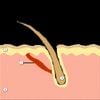TLDR The conclusion is that new methods for isolating hair cuticle cells and removing the cuticle layer are effective and convenient.
Researchers developed enzymatic methods to isolate and remove cuticle cells from human hair shafts. Using esperase for 3 days, cuticle cells were effectively harvested, while combining L-cysteine with esperase or savinase removed the entire cuticle layer within 4 hours. The isolated cuticle cells and descaled hair were analyzed, revealing that cuticle cells mainly contain β-sheets and random coil structures, and are more thermally stable below 260°C compared to descaled hair, which contains more α-helical structures. These methods are convenient, easily controlled, and useful for surface modification and structural disintegration of hair fibers.
27 citations
,
May 2019 in “Cosmetics” The hair cuticle is made of tough proteins that protect the hair, but more research is needed to fully understand its structure.
33 citations
,
September 2018 in “Frontiers in Microbiology” Human hair shafts inhibit Gram-positive bacteria growth but not Gram-negative bacteria.
107 citations
,
October 2014 in “PeerJ” Hair's molecular structure is mostly consistent, but genetic differences affect lipid types, which could help diagnose diseases.
9 citations
,
July 2014 in “Skin research and technology” Stretching damages Caucasian hair's structure more easily than Asian hair.
 54 citations
,
January 2013 in “Journal of Biological Macromolecules”
54 citations
,
January 2013 in “Journal of Biological Macromolecules” A new method effectively separates keratin-associated proteins and keratin from human hair.
254 citations
,
January 2007 in “Chemical Society Reviews” Hair is a complex protein fiber with unique properties useful for developing hair products.
272 citations
,
September 2001 in “Journal of Biological Chemistry” Human hair keratins were cataloged, showing their roles in hair differentiation stages.
30 citations
,
January 1994 in “Micron” Mature hair surfaces are formed by keratinized cells with developed layers, not just modified plasma membranes.


